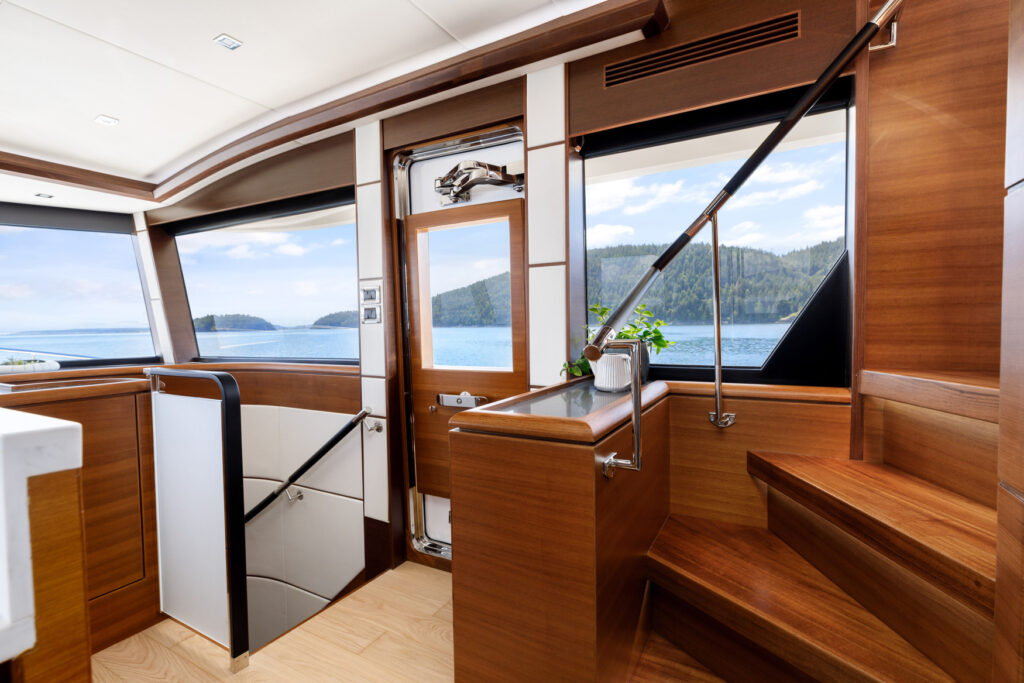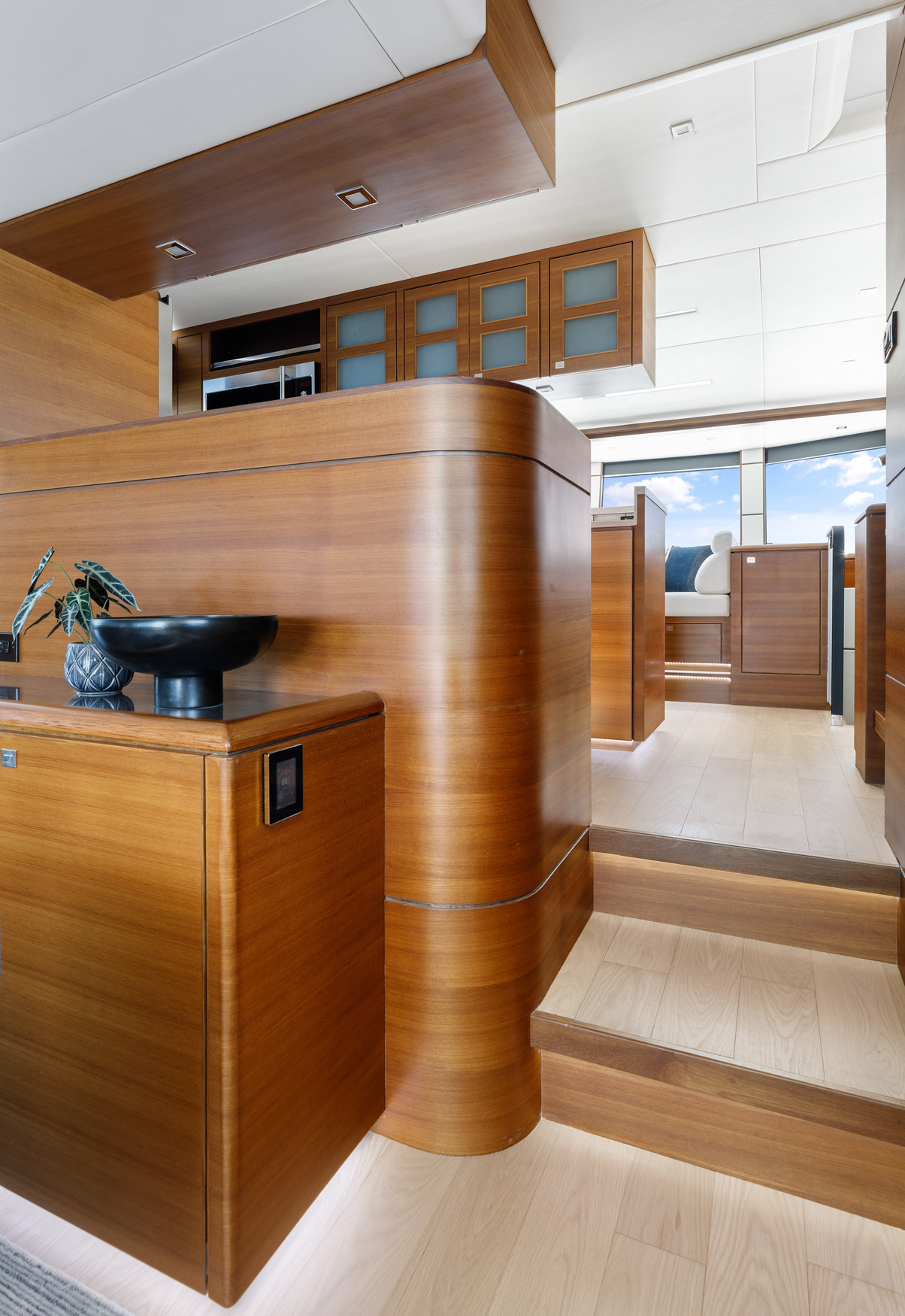Yes, shipwrights absolutely still exist—though their role has evolved alongside modern boatbuilding methods. Traditionally, shipwrights were the master craftsmen behind timber hulls, hand-shaped frames, and plank-on-frame construction. While those full-wood builds are less common today, the skills and mindset of a shipwright are very much alive in the custom yacht industry. We still work with marine professionals who carry that same deep understanding of structure, form, and material behavior—especially when handling cold-molded hulls, complex joinery, or restoring classic vessels. These craftsmen are often involved in tasks like teak decking, interior woodworking, and solving structural challenges that don’t come with an instruction manual.
In many ways, the modern shipwright blends tradition with innovation. They might be just as comfortable with epoxy and vacuum bagging as they are with a hand plane or mallet. In our shop, we’ve seen shipwrights take on roles that span fabrication, carpentry, and systems coordination—especially on custom or semi-custom builds where no two yachts are the same. Their value isn’t just in their tools, but in their ability to think like builders, solve problems with their hands, and bring a level of detail that elevates the entire project. So while you won’t find many building 18th-century schooners from scratch, shipwrights are still very much part of the modern marine world—and for the kind of boats we build, their expertise is irreplaceable.

The Definition and Origins of the Shipwright Role
Traditional Meaning of a Shipwright
A shipwright has traditionally been defined as a highly skilled craftsperson responsible for building and repairing wooden ships and boats. In the age of sail, shipwrights were the master builders behind full timber hulls—designing and executing everything from keel laying to final planking. Their core skills included lofting (translating ship plans to full-scale templates), framing, fairing, caulking seams with oakum, and shaping every piece of timber by hand to fit into the vessel’s complex geometry.
These were not general laborers. The shipwright trade demanded deep understanding of wood species, hydrodynamics, and joinery techniques. Apprenticeship was the main path to learning the craft, often through generational knowledge passed down in families or local yards. A shipwright could spend decades mastering their trade, and their work directly impacted the seaworthiness and longevity of every vessel they touched.
Evolution of the Term Over Time
As metal and composite materials became standard in yacht construction, the classical definition of a shipwright began to shift. Today, the term is used more broadly. In some yards, a shipwright might be someone working on structural repair or joinery, even in fiberglass vessels. In others, the title is still reserved for master craftsmen who specialize in wooden construction or heritage projects.
The regional use of the word also varies. In countries like Australia or the UK, the term “shipwright” may still be commonly used across marine trades, whereas in North America it often denotes traditional skill or work in restoration. Regardless of region, the title carries a level of respect for those who bring both craftsmanship and marine-specific knowledge to the build process.
The Role of Shipwrights in Modern Boat Building
Where Shipwrights Still Work Today
Shipwrights remain active in several sectors of the marine industry. Specialized wooden boatyards—often focused on classic yachts or custom day boats—still rely on traditional shipwright techniques. Historic preservation organizations employ shipwrights to maintain or restore iconic vessels, such as tall ships or museum-quality schooners.
In the modern yacht industry, there’s also a growing appreciation for traditional craftsmanship. High-end custom builders and refit yards often include shipwrights on their teams to handle timber framing, hull fairing, or artisan-level detailing. While the structure may be composite, the finishing work still calls for a shipwright’s precision.
What Skills Shipwrights Still Use in the Industry
Even on contemporary builds, shipwright skills remain relevant. Timber framing and cold-molding techniques are still used in select custom projects. Many builders continue to incorporate traditional joinery into interiors or teak decking, where mechanical fasteners are hidden and symmetry is key.
Shipwrights today often work alongside naval architects and engineers to bring hybrid construction projects to life—blending classic materials with modern systems. Their practical expertise in form, fit, and finish allows them to solve problems on builds that deviate from standardized production.
Shipwrights in Contemporary Yacht Construction
How Shipwright Knowledge Enhances Custom Yacht Builds
In a custom yacht, not every curve or corner fits a mold. Shipwrights excel in these areas—trimming bulkheads, shaping curved cabinetry, or solving structural alignments by eye and by hand. Their craftsmanship enhances interior layouts, makes tight spaces more efficient, and allows for seamless transitions between hull and furniture.
When building with carbon fiber, resin-infused cores, or complex laminates, there are still plenty of places where old-world skills meet new-world materials. Teak toe rails, solid wood soles, and hand-fitted storage solutions often rely on shipwright techniques to look and perform their best.
Our Work with Skilled Marine Craftsmen
We regularly work with craftsmen who embody the shipwright tradition—even if they don’t always use the title. Their experience is critical on projects involving detailed woodworking, teak decking, or custom bulkhead framing. These builders help bring warmth and human touch to high-tech hulls.
In our facilities, we integrate shipwrights into multidisciplinary teams. Whether they’re templating a curved companionway or laying out a seamless salon floor, their knowledge makes a measurable difference in the finished yacht. We also value these roles for what they pass along—training the next generation in skills that would otherwise fade. The legacy of the shipwright may have changed shape, but it’s far from obsolete.

Training and Education for Modern Shipwrights
Where Today’s Shipwrights Are Trained
While the traditional shipwright often learned through apprenticeship alone, today’s professionals benefit from a mix of hands-on experience and formal education. Institutions like The Landing School in Maine or the IYRS School of Technology & Trades in Rhode Island offer structured programs that cover traditional wooden boatbuilding, modern composite fabrication, and marine systems integration. These schools combine historical techniques with the latest in materials science, ensuring graduates are ready to work in both restoration and advanced yacht construction environments.
Many shipwrights also learn through mentorship at small boatyards or custom builders, where the pace allows for real-time teaching. This type of apprenticeship-style training is still highly valued, especially for those working with cold-molded hulls, traditional planking, or fine interior joinery. Continued education has become a key factor too, as modern shipwrights need to understand epoxy chemistry, vacuum bagging, and CAD integration to work effectively in today’s hybrid build environments.
Certification, Licensing, and Accreditation
Unlike some trades, there is no universal licensing body for shipwrights, but certain certifications can increase credibility and earning potential. Regional requirements vary—some countries or provinces may require documentation for marine trade work, while others rely on portfolio and experience alone. In the U.S., certification through trade schools or respected marine associations is often sufficient.
Organizations like the American Boat & Yacht Council (ABYC) and the National Marine Electronics Association (NMEA) offer training programs and credentials that apply to shipwright-adjacent disciplines. While not exclusive to shipwrights, these certifications demonstrate competence in systems design, safety standards, and best practices—skills that overlap with the broader responsibilities of modern marine craftsmen.
How the Shipwright Role Differs from Other Marine Trades
Shipwright vs. Marine Carpenter
While both roles involve woodworking, shipwrights typically have a broader understanding of the boat’s structure. Marine carpenters focus heavily on interior joinery, cabinetry, and trim, while shipwrights handle hull shaping, framing, and deck structures. The distinction often comes down to scope: a shipwright is involved earlier in the build and sees more of the vessel’s full structural lifecycle.
Shipwrights may also be more involved in interpreting design plans or adjusting layouts in real-time to resolve build issues. Marine carpenters generally follow a more fixed blueprint, working with pre-measured materials inside completed structures.
Shipwright vs. Boatbuilder or Fabricator
Boatbuilders and fabricators often work within production environments using molds and modular systems. Their focus is on efficiency, repeatability, and consistency across models. Shipwrights, by contrast, tend to work in custom or semi-custom contexts, where every component may be different from the last.
Shipwrights often act as creative problem-solvers, crafting solutions where off-the-shelf parts or standard processes don’t apply. This makes them particularly valuable in projects that involve restoration, unique designs, or detailed modifications.
Shipwright vs. Project Manager or Naval Architect
Shipwrights and naval architects work in tandem but come from different backgrounds—practical vs. theoretical. A naval architect focuses on the design, calculations, and structural integrity on paper (or software), while the shipwright is the person who turns that plan into a working vessel. In some smaller or specialized builds, shipwrights may even take the lead role in interpreting and executing the design.
Compared to project managers, shipwrights are deeply hands-on. While a project manager coordinates schedules, suppliers, and budgets, the shipwright deals with physical fit, build challenges, and the fine details of construction. Their experience is often critical in informing build sequences or flagging engineering conflicts early.
Cultural and Heritage Value of the Shipwright Profession
Preserving Maritime Craftsmanship
The shipwright trade holds immense historical value. In an era where automation is taking over many industries, the techniques practiced by traditional shipwrights remain largely manual and skill-based. Preserving this knowledge is vital for maritime heritage, especially when maintaining or replicating classic vessels.
Many shipwrights today contribute to documentation efforts—recording joinery techniques, lofting methods, or tool-making skills that aren’t widely taught. These archives ensure that future generations can carry forward the legacy of traditional marine craftsmanship.
Famous Examples and Ongoing Projects
Some of the world’s most recognized yachts and historic ships have relied on shipwrights for their restoration or replication. Projects like the USS Constitution, the Charles W. Morgan, and various J-Class racing yachts required exacting work that only shipwrights could provide. Their ability to understand legacy construction techniques—while blending them with modern expectations for performance and safety—is what makes their contribution so critical.
High-end custom yachts today continue to benefit from this legacy. In restoration or refit scenarios, shipwrights are often the only professionals with the skill set needed to reverse-engineer components or replicate design features from decades past.
Why the Shipwright Still Matters
Demand for Traditional Skills in High-End Yachting
Owners of custom yachts increasingly seek out craftsmanship that reflects quality, character, and uniqueness. Shipwrights bring a level of detail and artistry that can’t be replicated through mass production. From curved staircases and radius cabinetry to hand-fit teak decks, these elements are what turn a boat into a bespoke vessel.
In refit projects, particularly those involving wooden hulls or classic interiors, shipwrights are essential. They understand how to blend new systems into old structures, preserve patina where desired, and restore function without losing heritage.
Hybrid Roles in Modern Boatyards
In today’s yards, shipwrights often take on broader responsibilities. Many are cross-trained in electrical, mechanical, or composite fabrication. This allows them to move fluidly between departments, filling gaps where precision and problem-solving are required.
Their ability to adapt traditional techniques for modern designs makes them uniquely valuable. On our build floors, shipwrights are where tradition meets innovation—they shape not just the materials but the culture of craftsmanship that defines a truly well-built yacht.

Contact Us
At North Pacific Yachts, we’re here to make your journey to owning the perfect yacht seamless and enjoyable. Whether you’re looking for expert guidance on model specifications, insights into custom build options, or simply need a few questions answered, our team is ready to assist. With years of experience in yacht building, we’re dedicated to understanding your unique vision and helping you navigate the entire process with ease. Reach out to us by email at info@northpacificyachts.com for personalized responses to all your inquiries.
If you’d prefer a conversation, we invite you to give us a call at 1-877-564-9989. Speaking directly with our experienced team can provide immediate answers and professional insights into everything from specific build features to delivery timelines. At North Pacific Yachts, your satisfaction is our top priority, and we’re here to ensure you’re confident and informed at every step of your yacht ownership journey.
See our models here:
Related Posts
Do You Legally Have to Name a Boat?
How Much Do Boat Builders Make?


